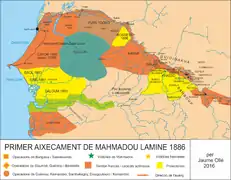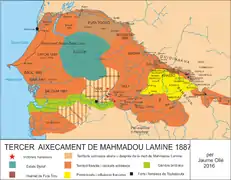Mahmadu Lamine
al-Hajj Mahmadu Lamine Drame (died 9 December 1887) was a nineteenth-century Tijani marabout who led an unsuccessful rebellion against the French colonial government in .
Early life, education, and hajj
Mahmadu Lamine Drame, also known as Ma Lamine Demba Dibassi, was born between 1835 and 1840 at Goundiorou, near Kayes in what is now Mali.[1][2] Educated in the Qur'an first by his father, a cleric, Lamine studied as well at Tabajang in Casamance and Bunumbu in Kantora before later study under Fodé-Mohammed-Saloum at Bakel.[1]: 53,56 He traveled to Ségou, probably after 1850, where he met Umar Tall and may have served him.[1]: 56 Some time between 1864 and 1874, Lamine went on a hajj, likely leaving Ségou a while after the death of Umar Tall and returning between 1878 and 1880.[1]: 57,62 Upon his return, he was imprisoned by Tall's son Ahmadu Tall.[3]
Uprising
- The political situation during Mahmadu Lamine's three rebellions
 1886
1886 1886-1887
1886-1887 1887
1887
Lamine returned to the Upper Senegal and began gathering followers, his claims of friendship with the French notwithstanding. In February 1886, Lamine proclaimed a jihad against Bundu, ruled by a new almamy who was controlled by the French,[4] and captured the capital of Boulibani. He besieged the French in their fort at Bakel, but the siege was broken by reinforcements coming from Kayes and he retreated south. The French, supported by Toucouleur and Moorish auxiliaries, burned a hundred villages in the area in revenge.[5]
Lamine re-established himself at Diana, in what is now the Tambacounda region. From there, he re-invaded Bundu, killing the puppet Almamy Omar Penda. In December 1886, two French columns led by Lt. Col. Joseph Galliéni and battalion chief Vallière captured the town and chased him away.
Following this defeat, Lamine regrouped at Toubakouta in Niani, launching his next attack in the Kingdom of Wuli in July 1887. The capital of Netteboulou was sacked and the king, another puppet of the French, was executed. Galliéni seized Toubakouta on 8 December 1887. This time, Lamine was captured, and was executed by French forces on the following day.[5] His skull currently resides in the Musée de l’Homme.[6]
References
- Fisher, Humphrey (1970). "The Early Life and Pilgrimage of Al-Hajj Muhammad Al-Amin the Soninke (d. 1887)". The Journal of African History. 11 (1): 51–69. doi:10.1017/s0021853700037439. JSTOR 180216. S2CID 162684356.
- Daniel Nyambarza. “Le Marabout El Hadj Mamadou Lamine d’après Les Archives Françaises.” Cahiers d’Études Africaines, vol. 9, no. 33, 1969, pp. 124–45. JSTOR, http://www.jstor.org/stable/4391033. Accessed 4 July 2023.
- Isichei, Elizabeth (1977). History of West Africa since 1800. New York: Africana Publishing Company. p. 52. Retrieved 31 May 2023.
- Isichei, 53.
- Drame, B. "Histoire: Qui Est Mamadou Lamine DRAME ?". Mali Info. Retrieved 31 May 2023.
- Méheut, Constant (2022-11-28). "A Paris Museum Has 18,000 Skulls. It's Reluctant to Say Whose". The New York Times. ISSN 0362-4331. Retrieved 2022-11-29.